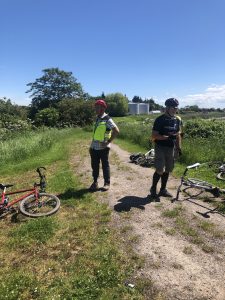Introduction
The BACC ‘Cycle Audits’ were conducted in Bridgwater over the first two years since our group was established. Initially, five BACC members received comprehensive training provided by the Somerset County Council (SCC) Commissioning team and a WSP contractor. This training lasted several weeks and included both classroom work and bike trial surveys conducted throughout the town.
Following the training, we began the task of conducting the cycle audit processes in phases. These deliberate steps were taken to ensure that we were well-prepared and understood the task at hand. This involved gathering knowledge, receiving training, technical support, and insight. Our goal was to carry out a comprehensive audit of Bridgwater and its districts, determining the current state and identifying areas that require improvement.
We carefully documented the detailed audit findings in a logical manner, making the information easily accessible for future reference. Additionally, we created a mapping system that accurately represents the existing cycling and walking network, as well as any proposed route improvements. Our aim is to utilize all this information and analysis to develop specific route feasibility studies or ‘oven-ready packages’.








Preparation Phase
During this phase of the ‘Cycle Audit’ process, we carried out a detailed analysis using the Local Walking & Cycling Infrastructure Plan (LCWIP) Technical Guidance for Local Authorities. This stage involved mapping Bridgwater and considering various factors outlined in the technical guidance, such as cycle desire lines and the propensity to cycle tool analysis. We also took into account Sustrans advice on identifying areas that attract people who walk or cycle.
To facilitate our planning, we created an ‘Attractors Map‘ which helped us identify the appropriate corridors and routes. We focused on determining the major commuting corridors, ideal link routes between these corridors, and the main destinations that people currently cycle to or are likely to cycle to in the future. The major corridor priorities were identified as follows: Dunball to North Petherton for the North-to-South corridor, and Cannington to Westonzoyland for the West-to-East corridor. Additionally, we divided routes through and across the town into district routes, including Wembdon, Durleigh, Newtown, Eastover, Westover, Hamp, Sydenham, Bower, Stockmoor, Wilstock, and more. We also developed a town centre ring that encompasses the river, docks, canal, quiet streets, and Blake Gardens.
For a comprehensive understanding of how we utilized the design factors and attractors, as well as the complete process of gathering information and creating a suite of maps, please refer to the ‘Bridgwater Maps‘ page.
Audit Training and RST Analysis
To help assess and compare potential routes for inclusion in the Bridgwater network, a Route Selection Tool (RST) was essential.
The primary function of the tool is to assess the suitability of a route in its existing condition against the core design outcomes and then compare this with the potential future state, if improvements were made. Also using this tool routes can be easily compared.
Route Selection Tool Criteria Design Outcomes
The RST uses a range of criteria to assess how well a route meets the core design outcomes for cycling ranging from 5, being the highest, to 0, being the lowest. The design outcomes are, namely Coherent – route connectivity, are continuous & easy to use, Directness – keeping to the fastest & straightest route, not always ideal, Safety – primary element, assessing traffic, dangerous junctions, vehicle speeds and the other hazards, Comfortable – good road/path surface, feeling of being safe and Attractiveness – enjoyable surroundings and environment.
An RST comprehensive Excel spreadsheet (takes time to load) was used (following much training) to record all ‘Cycle Audit’ findings in one neat area. This example sheet shows the scope of work, our comprehensive analysis and the ‘design outcome’ tab functions.


Cycle Audit Surveys
In preparation for these audits the BACC audit team carried out an extensive overview of Bridgwater streets and outlying village areas. Many hours of dedicated work!
In brief, the audits were conducted gathering a lot of evidence and survey findings, this consisted of three main documented elements, which were; An Overview Map of route audited – usually route(s) will cover an area of between 2 – 5 km, a Detailed Audit RTS Spreadsheet (takes time to load) – this contains all text analysis findings based against the five design outcomes, namely; coherent, directness, safety, comfort & attractiveness and finally a Route Video – descriptive video on the whole route with major safety & cost factors noted.
At the conclusion of almost two years’ work, thirty-five audit folders have been amassed. Each folder contains all the information required to assess whether an existing route should be improved, a new route should be built or the route is not suitable or impractical to change.
From here we have moved on to phase four, which means we can use all of this amassed data & analysis to create specific individual reports, such as Intervention Reports and Feasibility Studies. These reports are the starting blocks for actually getting new or improved routes built or designed routes challenged. Go to BACC Reports to see more.
